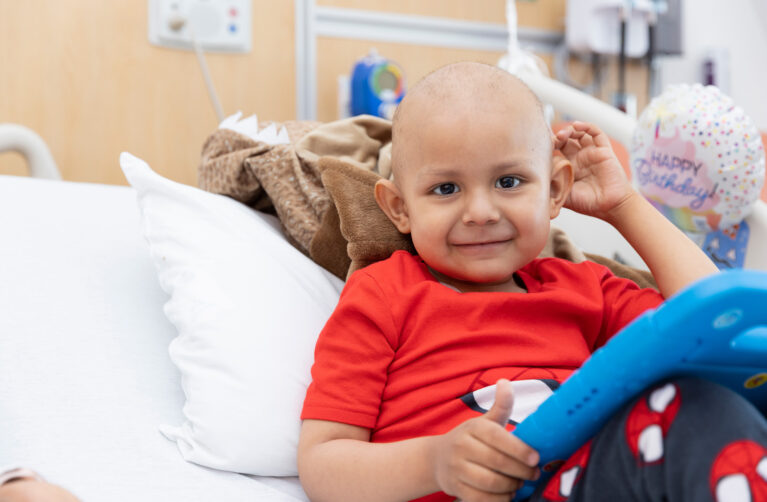Jeremiah Kwakye of San Jose was just 15 months old when his parents brought him to Lucile Packard Children’s Hospital for a life-saving liver transplant. “I handed my son to the surgical team and said, ‘This is the only child I have, so I need you to take really good care of him,’” recalls Andrea Kwakye, Jeremiah’s mother. “That’s when I lost it. I still get all teary-eyed just thinking about that day.”
When Jeremiah awoke after five hours in surgery, his condition had already improved dramatically. “The first thing I noticed was his beautiful white eyes,” Andrea says. “It was shocking, because they had been yellow since the day he was born.”
Jeremiah Kwakye
Jeremiah’s jaundiced eyes were caused by an extremely rare inherited liver disease called Crigler-Najjar syndrome, a condition that affects fewer than one in a million newborns. The disease is caused by a genetic defect in the liver that prevents the breakdown of bilirubin, a yellowish pigment that’s a byproduct of discarded red blood cells. Over time, the accumulation of excess bilirubin in the bloodstream can result in brain damage.
Packard surgeon Carlos Esquivel, MD, PhD, and his colleagues in the children’s liver transplant program recommended replacing Jeremiah’s liver with a healthy organ capable of producing a bilirubin-busting enzyme.
“Twenty-five years ago, a child under age 2 like Jeremiah was not given the opportunity to have a liver transplant, because the mortality was so high,” says Esquivel, the Arnold and Barbara Silverman Professor in Pediatric Transplantation. “In our program today, the survival rate for children of all ages is close to 100 percent.”
Jeremiah, now 7, is one of those success stories. “He’s doing phenomenally well,” Andrea says. “He does what a typical first-grader does—plays, runs, and drives his parents crazy. He eats a lot, he’s growing, and he’s smart as a whip.”
Andrea credits her son’s remarkable turnaround to the extraordinary care provided by a dedicated team of surgeons, nurses, hepatologists, gastroenterologists, anesthesiologists, physician assistants, transplant coordinators, social workers, developmental specialists, dieticians, and pharmacists.
“We had such an awesome transplant team, Jeremiah couldn’t help but do well,” says Andrea. “They’re very compassionate, honest, and caring. They want your child to be well and to grow up healthy.”
Transplant Leader
The pediatric transplant team at Packard Children’s performs nearly 70 liver and kidney transplants a year, many in high-risk infants and newborns. “Small livers have very small blood vessels,” says Esquivel, chief of the division of transplantation at the Stanford School of Medicine. “If the vessels clot, the liver will do poorly. You have to use very fine sutures, ones that you can’t even see with the naked eye.”
Since 2006, Packard has consistently ranked among the top three pediatric liver and kidney transplant centers in the United States in terms of number of transplants, successful patient outcome, and graft survival, according to the U.S. Department of Health & Human Services.
“We’re one of the few places that also performs multi-organ transplants,” Esquivel adds. “We’ve done combined liver-kidney, liver-heart, liver-intestine, and the first pediatric liver-double lung transplant. One advantage of being treated here is that we have so many transplant specialists on site.”
Esquivel helped pioneer several innovative surgical techniques now used at pediatric hospitals worldwide. “Because of the chronic shortage of organ donors, we’ve had to be creative,” he explains. “For example, we figured out how to take a liver from a deceased adult donor and trim it down to a size that would fit a small child. In Jeremiah’s transplant, I only used about 40 percent of the donor liver. We were also among the first to transplant part of a liver from a living adult to a child. The transplanted portion grows to normal size, and the donor’s liver also grows back.”
Jeremiah Kwakye
Today, the transplant team at Packard treats more children with liver cancer than any other U.S. hospital. “About 80 percent of our liver transplant patients have no recurrence of their cancer,” says Kenneth Cox, MD, chief of pediatric gastroenterology, hepatology, and nutrition. “We also see children with rare metabolic diseases that can damage the brain, kidney, heart, and other organs. Our goal is to transplant the liver before that damage occurs.”
Packard’s emergence as a national transplant leader is due in large part to an unrivaled patient outreach service. A network of outreach clinics spans across the western United States, with locations in California, Hawaii, Nevada, New Mexico, Oregon, and Washington. Packard physicians and transplant coordinators make on-site evaluations and referrals, and provide ongoing post-transplant care in close coordination with families and their local pediatricians.
Studies show that Packard’s outreach clinics have achieved a remarkably high success rate in isolated areas across the rural West. “That’s because we integrate children back into their community, and educate the community on how to care for them,” says Cox. “It’s a unique model, and it’s the way health care should be practiced.”
Lifelong Care
"One thing the transplant team teaches you is that the surgery is not the final component of treatment,” notes Andrea Kwakye. “This is a lifelong process for your child.”
Her son, Jeremiah, continues making regular visits to Packard to fine-tune his immunosuppression medication so that his body won’t reject the transplanted liver. It’s a delicate balancing act, because too much immunosuppression could trigger a deadly infection of Epstein-Barr virus, or EBV, which can then lead to cancer.
Jeremiah Kwakye
“EBV infection is one of the highest-risk complications in pediatric transplantation,” says Cox. “Packard has been a leader in studying how to prevent EBV from forming cancers in kids. We used to see about a 6 percent risk of young transplant patients getting cancer, now it’s dropped to 1 percent. We hope to eliminate that risk entirely in the very near future.”
Packard physician-scientists are also looking for ways to minimize the use of immunosuppressive drugs. “We’re doing quite a bit of research to better understand the mechanisms of organ rejection,” says Esquivel. “It’s sophisticated work involving molecular biology and genetic studies.”
It is estimated that as many as 25 percent of children who undergo liver transplants might not need immunosuppressants. “The problem is that we don’t yet have a test to identify which children are prone to rejection and which are not,” says Esquivel. “We were the first to report that young children may develop tolerance—in other words, their immune system might eventually learn to tolerate the graft. But we don’t have a good way of knowing when it’s safe to stop giving medication. Right now it’s just a matter of trial and error.”
Cox and his colleagues are developing innovative therapies that could prevent the need for transplants in certain diseases. “In 1993, I discovered that a rare liver and colon disease called primary sclerosing cholangitis (PSC) can be treated with the oral antibiotic vancomycin,” says Cox. “I had been using vancomycin to treat a child with PSC for a separate bacterial infection, and noticed that the PSC had also disappeared. At the time, the primary treatment for PSC was a liver transplant, but with vancomycin, the transplant was avoided. We’re still trying to better understand how the drug makes this disease go away. At Stanford you can do that kind of research, because you have top scientists from many disciplines to collaborate with.”
Recently, surgeon Stephan Busque, MD, of Packard’s kidney transplant program demonstrated that adult patients could be weaned off anti-rejection medication by suppressing their immune system with radiation, then infusing their thymus with immune cells from the donor. This groundbreaking therapy may soon be tested in younger patients.
“Our obligation is to care for children,” says Packard gastroenterologist William Berquist, MD. “That’s the responsibility we have, and one that we gladly welcome. When you take care of a little baby and then you see her graduate from high school, that’s tremendously gratifying.”
Organ Shortage
One of the biggest problems in transplant medicine is the nationwide shortage of donor organs. “There is a tremendous amount of anxiety for families in the waiting period,” says Debra Strichartz, RN, the liver and intestinal transplant program manager. “Occasionally there are patients who don’t get an organ in time.”
Karla Corona of South San Francisco, then 18, was placed on the national kidney waiting list in 2010 after doctors at Packard Children’s discovered that her kidneys were too small to function properly. Fourteen months later, she finally received a call that a donor kidney was available.
“I was nervous,” Karla says. “When they told me they’d found a donor, all the emotions really came to me. But when I arrived at Packard everyone made me feel so comfortable.”
Karla Corona
Karla’s transplant began at midnight and ended around 4 in the morning. Surgeon Waldo Concepcion, MD, opted to keep Karla’s kidneys intact, so now she has three—two small kidneys and a normal-size adult one.
“Our passion is children,” says Concepcion, chief of pediatric kidney transplantation. “They depend on us to provide life for them. So if there’s a transplant at midnight or five transplants in two days, they’re all going to be done, because you don’t know when the next organ will be available.”
A large percentage of kidney transplant patients at Packard are under 2 years old. Many of these small children receive organs from adult donors, a technique pioneered by Oscar Salvatierra, MD, professor emeritus of surgery and of pediatrics.
“One advantage of an adult-size kidney is that the blood vessels are larger and don’t clot,” says Concepcion, professor of surgery at Stanford. “The donors are primarily parents—the best of the best donors—so there is also an immunologic advantage in early infants.”
For decades, steroids were a cornerstone of post-transplant therapy. But in the 1990s, Salvatierra introduced steroid-free immunosuppression, now the standard of care for kidney transplants. “A child from the old era of transplantation often battles deformities produced by steroids—hip dysplasia that eventually requires surgery, weak bones that form arthritis at the joints, as well as diabetes, infections, and metabolic problems,” Concepcion explains. “We have to do more than just give them life from transplantation. We also have to give them a successful life, and that includes taking steroids out of the picture. That has been done.”
Future Directions
In 2007, Packard opened a state-of-the-art dialysis unit for kidney patients awaiting donor organs. But for kids awaiting a liver transplant, dialysis is not an option. To address that challenge, Esquivel and Olivia Martinez, PhD, professor of surgery, are exploring the use of stem cells as a possible bridge to transplantation. For children like Jeremiah, stem cells might eventually be used to replace the damaged gene that prevents the breakdown of bilirubin in the blood. “Right now, if one gene is defective we have to replace the entire liver, which seems like overkill,” Esquivel says. “So the potential of stem cell research is huge.”
As associate director of the Stanford Institute for Immunity, Transplantation, and Infection (ITI), Esquivel is working with other researchers to develop a better understanding of the immune system to design targeted therapies that prevent organ rejection and treat a broad range of immunological diseases.
Concepcion, a research associate at ITI, is developing a multidisciplinary consortium of researchers from different specialties to find new treatments for individual transplant patients. “Right now we have a cookie-cutter approach that fits everybody,” he says. “We want to have individualized care to prevent viral infection and rejection, and to create the longest graft life a patient can have.”
Karla Corona
For Karla, now 19, the prognosis is very good. She’s in college, has a boyfriend, and is careful about taking her immunosuppression drugs. “I was told that my kidney might last 50 years,” she says. “It depends on me and the way I take care of it.”



